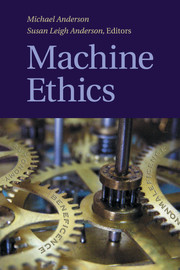Book contents
- Frontmatter
- Contents
- General Introduction
- PART I THE NATURE OF MACHINE ETHICS
- Introduction
- 1 The Nature, Importance, and Difficulty of Machine Ethics
- 2 Machine Metaethics
- 3 Ethics for Machines
- PART II THE IMPORTANCE OF MACHINE ETHICS
- PART III ISSUES CONCERNING MACHINE ETHICS
- PART IV APPROACHES TO MACHINE ETHICS
- PART V VISIONS FOR MACHINE ETHICS
- References
3 - Ethics for Machines
from PART I - THE NATURE OF MACHINE ETHICS
Published online by Cambridge University Press: 01 June 2011
- Frontmatter
- Contents
- General Introduction
- PART I THE NATURE OF MACHINE ETHICS
- Introduction
- 1 The Nature, Importance, and Difficulty of Machine Ethics
- 2 Machine Metaethics
- 3 Ethics for Machines
- PART II THE IMPORTANCE OF MACHINE ETHICS
- PART III ISSUES CONCERNING MACHINE ETHICS
- PART IV APPROACHES TO MACHINE ETHICS
- PART V VISIONS FOR MACHINE ETHICS
- References
Summary
“A robot may not injure a human being, or through inaction, allow a human to come to harm.”
– Isaac Asimov's First Law of RoboticsThe first book report i ever gave, to mrs. slatin's first grade class in Lake, Mississippi, in 1961, was on a slim volume entitled You Will Go to the Moon. I have spent the intervening years thinking about the future.
The four decades that have passed have witnessed advances in science and physical technology that would be incredible to a child of any other era. I did see my countryman Neil Armstrong step out onto the moon. The processing power of the computers that controlled the early launches can be had today in a five-dollar calculator. The genetic code has been broken and the messages are being read – and in some cases, rewritten. Jet travel, then a perquisite of the rich, is available to all.
That young boy that I was spent time on other things besides science fiction. My father was a minister, and we talked (or in many cases, I was lectured and questioned!) about good and evil, right and wrong, and what our duties were to others and to ourselves.
In the same four decades, progress in the realm of ethics has been modest. Almost all of it has been in the expansion of inclusiveness, broadening the definition of who deserves the same consideration one always gave neighbors. I experienced some of this first hand as a schoolchild in 1960s Mississippi.
Information
- Type
- Chapter
- Information
- Machine Ethics , pp. 28 - 44Publisher: Cambridge University PressPrint publication year: 2011
References
Accessibility standard: Unknown
Why this information is here
This section outlines the accessibility features of this content - including support for screen readers, full keyboard navigation and high-contrast display options. This may not be relevant for you.Accessibility Information
- 12
- Cited by
